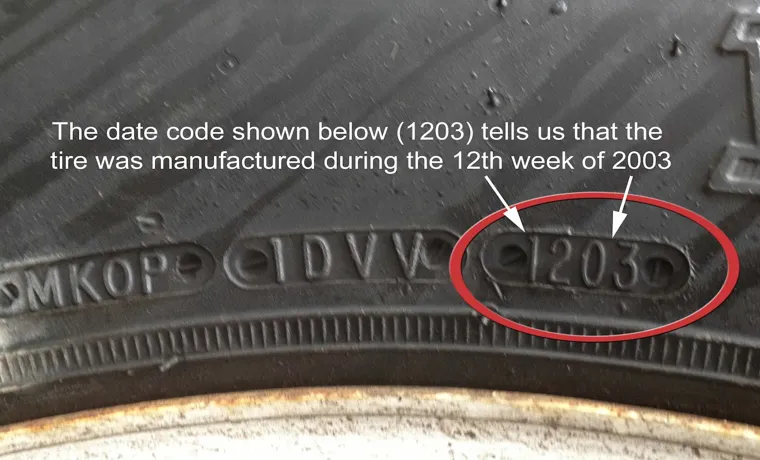Have you ever looked at the side of your tires and wondered what all those numbers and letters mean? Well, you’re not alone! Tire date codes can be confusing, but they are vital pieces of information that can affect your safety on the road. These codes tell you when your tire was manufactured, which is important because tires experience wear and aging even when they’re not being used. In this blog post, we’ll break down the tire date code and show you how to read it like a pro.
So buckle up, and let’s dive into the world of tire date codes!
Table of Contents
Locating the Tire Date Code
If you’ve ever wondered how to tell tire date, then you’re in the right place. The tire date code can be a confusing combination of letters and numbers, but it’s important to know how old your tires are. You can find the date code on the sidewall of the tire, near the edge of the rim.
It will be a combination of four digits, with the first two representing the week and the last two representing the year of manufacture. For example, if the code reads “3417,” it means the tire was made in the 34th week of 201 It’s essential to check the tire date code regularly, as tires can degrade over time even if they haven’t been used much.
If your tires are more than six years old, it’s time to consider replacing them for your safety on the road. Remember, keeping an eye on your tire date code can help keep you safe and prevent any potential accidents on the road.
Find the DOT Number
If you want to locate the DOT number on your tire, you need to know how to read the tire date code. The DOT number is a unique identifier that tells you important information about your tire, such as where it was manufactured and when it was made. To find the DOT number, look for a combination of letters and numbers on the sidewall of the tire.
The DOT number is typically located on the outer edge of the tire, but it can also be found near the bead area. The last four digits of the DOT number represent the week and year the tire was manufactured. For example, if the last four digits are 4519, the tire was made in the 45th week of 201
It is important to check the DOT number on your tires regularly to ensure they are not expired or aged out. Using old or expired tires can be extremely dangerous and can lead to accidents on the road. So, be sure to keep an eye out for the DOT number and use it to stay safe while driving.

Identify the Last Four Digits
If you want to know when your tires were made, you’ll need to find the tire date code. This code can be found on the sidewall of your tire and it usually starts with the letters DOT. The last four digits of the code are what you need to look at to determine the age of your tire.
The first two digits represent the week of the year that the tire was made, while the last two digits represent the year. For example, if the last four digits read 4518 (45th week of 2018), then your tire was made in the 45th week of 201 It’s important to keep track of your tire’s age because as they get older, they can become more prone to defects and failures.
In fact, many experts recommend replacing tires that are more than six years old, even if they still have plenty of tread left. So the next time you’re inspecting your tires, make sure to locate the tire date code and check the last four digits to ensure your safety on the road.
Interpreting the Tire Date Code
Do you know how to tell when your tires were manufactured? Look at the tire date code on the sidewall. This is a four-digit number that tells you the week and year the tire was made. The first two digits represent the week of manufacture, while the second two digits represent the year.
For example, if the code says “3418,” the tire was made in the 34th week of 201 It’s important to know the age of your tires, as they can deteriorate over time, even if they appear to be in good condition. In general, it’s recommended that you replace your tires every 6 years, regardless of their mileage or appearance.
So be sure to check your tire date codes regularly and replace your tires when necessary to ensure your safety on the road.
Decoding the Last Four Digits
If you’ve ever wondered what the last four digits of the code on your tire mean, you’re not alone. This code is known as the tire date code, and it shows the week and year that the tire was manufactured. Understanding this code can help you make better decisions about when it’s time to replace your tires.
The last two digits indicate the year, while the first two digits show the week. So, if your code says “2619,” that means your tire was manufactured in the 26th week of 201 It’s important to keep in mind that even if your tire looks brand new, it may not be safe to use if it’s too old.
Tires can start to break down and lose structural integrity as they age, which can lead to blowouts or other dangerous situations on the road. So, if your tires are approaching their sixth birthday, it’s probably time to start thinking about getting new ones.
Understanding the Manufacturing Date
When it comes to purchasing new tires, it’s crucial to understand the manufacturing date. The date code is typically located on the sidewall of the tire and is a four-digit number. The first two digits represent the week of production, while the last two digits represent the year.
For example, if the date code says “0619,” it means that the tire was manufactured in the sixth week of 201 It’s important to note that tires have a lifespan of around six years, so if you purchase a tire that’s already a few years old, it may not last as long as a newer tire. Additionally, older tires may be more prone to cracking or blowing out, which can be dangerous while driving.
As a general rule of thumb, make sure to check the manufacturing date before purchasing tires to ensure that you’re getting the freshest product possible.
Determining the Age of the Tire
Determining the age of a tire is crucial for the safety and performance of your vehicle. One quick way to check the tire age is by interpreting the tire date code. This code is usually located on the sidewall of the tire and consists of four digits.
The first two digits represent the week of manufacture, while the last two digits represent the year of manufacture. For example, if the last two digits are 18, it means that the tire was manufactured in 201 It’s important to note that tires have a lifespan of around six years, after which they start to deteriorate and can become a safety hazard.
Therefore, if you’re purchasing a used car or haven’t replaced your tires in a while, it’s essential to check the age of your tires and replace them if necessary. Don’t compromise on your safety; always ensure that your tires are in good condition and within their lifespan.
Checking the Tire for Wear and Tear
Knowing how to tell the age of your tire is crucial when it comes to ensuring your safety on the road. Tire date codes are typically located on the sidewall of the tire, indicated by a four-digit number. The first two digits represent the week of production, while the last two digits represent the year.
For example, if the number is 2318, it indicates that the tire was manufactured on the 23rd week of 201 It is essential to check for wear and tear on your tire regularly, as it can significantly affect your vehicle’s performance. Signs of excessive wear include uneven tread wear, cracks on the surface, and shallow depth in the treads.
If you notice any of these signs, it is crucial to have your tire checked by a professional immediately. Neglecting these warning signs can lead to tire blowouts, which can be dangerous on the road. Always keep in mind the age of your tire and inspect it regularly, so you can stay safe and avoid any potential road hazards.
Inspecting the Tread Depth
Inspecting the tread depth of your tires is important to ensure your safety on the road. As your tires age and are exposed to wear and tear, their grip on the road can be compromised, leading to a greater risk of accidents. It’s recommended to check your tire’s tread depth at least once a month to ensure it’s within a safe range.
One way to do this is by using a tread depth gauge, which measures the depth of the grooves on your tire. If the depth falls below 2/32 of an inch, it’s time to replace the tire. However, checking the tread depth isn’t the only thing you should be aware of.
You should inspect your tires for any signs of wear and tear, such as cracks, bulges, or cuts in the rubber. These issues can also compromise your tire’s grip and make it more susceptible to a blowout. Additionally, uneven wear on your tires can indicate an alignment issue with your vehicle.
Regularly inspecting your tires for wear and tear can save you money in the long run by catching issues before they become major problems. It’s important to keep in mind that your tires are the only part of your vehicle that makes contact with the road, so it’s crucial to keep them in good condition. Don’t wait until it’s too late, inspect your tires regularly to ensure your safety on the road.
Measuring the Tread Depth with a Coin
Maintaining proper tire condition is crucial for a safe and smooth driving experience. To ensure this, regular inspections of the tire for wear and tear are necessary. Measuring the tread depth is one of the important aspects of tire inspection.
One simple method of checking tread depth is by using a coin. Insert a penny into the tread groove with Lincoln’s head facing downwards. If the top of Lincoln’s head is visible, the tire’s tread depth is too low, and it’s time for a replacement.
The penny test is a quick and easy way to check tire tread, but it is important to remember that it is not the only method to check for tire wear. Even if the tread depth looks good, inspect the tire for any cuts, cracks, bulges, or punctures that may compromise its safety on the road. Remember, maintaining proper tire condition is crucial for safe driving, so make sure to inspect your tires at least once a month.
Checking for Cracks and Bulges in the Sidewalls
When it comes to making sure your tires are in good condition, checking for cracks and bulges in the sidewalls is essential. These signs of wear and tear can lead to a blowout or other dangerous situations on the road. To check your tires properly, start by examining the sidewalls for any visible cracks or bulges.
If you notice any irregularities, it’s best to have your tire inspected by a professional. They can determine if it’s safe to drive on or if it needs to be replaced. It’s also important to check the tread depth and monitor for uneven wear, as these issues can impact your vehicle’s performance and safety.
Remember, neglecting your tires can lead to costly repairs and even accidents. Make checking your tires a regular part of your vehicle maintenance routine to ensure your safety on the road.
Conclusion
Well folks, after all that tire talk, I hope you’re feeling more confident in how to tell the date of your tires. Remember to look for those four-digit codes stamped into the sidewall and don’t be fooled by that sneaky DOT number. It’s important to make sure your tires are relatively fresh so you can stay safe on the road.
So next time you’re checking your tires, don’t be befuddled by the date, but instead, be a savvy tire detective and know just how old those bad boys really are. Happy tire hunting!”
FAQs
What is a tire manufacturing date code?
The tire manufacturing date code is a four-digit number stamped on the tire sidewall that indicates the week and year of manufacture.
How can I find the tire date code on my tires?
Look for a four-digit number such as “4316” on the tire sidewall. “43” represents the week of manufacture and “16” represents the year (2016).
Why is it important to check the tire date code?
It’s important to check the tire date code because tires start to deteriorate over time, even if they have plenty of tread depth remaining. Using old tires can increase the risk of blowouts, punctures, and other tire-related accidents.
After what age should I consider replacing my tires?
Most tire manufacturers recommend replacing tires after six years regardless of tread depth. After 10 years, tires should definitely be replaced, even if they still have some tread left.
Can I use the DOT number to determine the tire date code?
Yes, the last four digits of the DOT number indicate the tire date code. The first two digits represent the week of manufacture and the last two digits represent the year. For example, “3014” would indicate that the tire was manufactured in the 30th week of 2014.
Are there any exceptions to the tire date code rule?
Yes, some tires may have a longer lifespan if they have been stored properly and not used frequently. However, it’s always best to err on the side of caution and replace tires that are approaching their recommended lifespan.
What factors can affect the lifespan of a tire?
Factors that can affect the lifespan of a tire include exposure to heat, sunlight, and moisture, as well as how often and how far the tires are driven. Proper inflation and regular maintenance can also extend the life of a tire.



